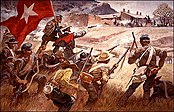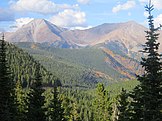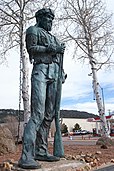Portal:Colorado/Selected article
WikiProject Colorado has selected the following articles for the Colorado portal.
Use
The layout design for these subpages is at Portal:Colorado/Selected article/Layout.
- Add a new selected article to the next available subpage.
- Biography articles should go on Portal:Colorado/Selected biography.
- The text should be approximately 60 words from the article.
- Update
{{Random portal component|max=total|seed=1|header=Selected article|subpage=Selected article}}on Portal:Colorado with the new selected article total.
Colorado selected articles list
Selected article 1
Portal:Colorado/Selected article/1
The Sand Creek massacre (also known as the “Battle of Sand Creek” Chivington massacre, the battle of Sand Creek or the massacre of Cheyenne Indians) was a massacre of Cheyenne and Arapaho people by the U.S. Army in the American Indian Wars that occurred on November 29, 1864, when a 675-man force of the Third Colorado Cavalry under the command of U.S. Volunteers Colonel John Chivington attacked and destroyed a village of Cheyenne and Arapaho people in southeastern Colorado Territory, killing and mutilating an estimated 69 to over 600 Native American people. Chivington claimed 500 to 600 warriors were killed. However, most sources estimate around 150 people were killed, about two-thirds of whom were women and children. The location has been designated the Sand Creek Massacre National Historic Site and is administered by the National Park Service. The massacre is considered part of a series of events known as the Colorado Wars. (Full article...) (Full article...)Selected article 2
Portal:Colorado/Selected article/2
The Continental Divide of the Americas (also known as the Great Divide, the Western Divide or simply the Continental Divide; Spanish: Divisoria continental de América, Gran Divisoria) is the principal, and largely mountainous, hydrological divide of the Americas. The Continental Divide extends from the Bering Strait to the Strait of Magellan, and separates the watersheds that drain into the Pacific Ocean from those river systems that drain into the Atlantic and Arctic Ocean, including those that drain into the Gulf of Mexico, the Caribbean Sea, and Hudson Bay.Although there are many other hydrological divides in the Americas, the Continental Divide is by far the most prominent of these because it tends to follow a line of high peaks along the main ranges of the Rocky Mountains and Andes, at a generally much higher elevation than the other hydrological divisions. (Full article...) (Full article...)
Selected article 3
Portal:Colorado/Selected article/3
The Amache National Historic Site, formally the Granada War Relocation Center but known to the internees as Camp Amache (pronounced a-ma-chee), was a concentration camp for Japanese Americans in Prowers County, Colorado. Following the Japanese attack on Pearl Harbor on December 7, 1941, Japanese Americans on the West Coast were rounded up and sent to remote camps. Among the inmates, the notation "亜町 (Amachi)" was sometimes applied.The camp, located 1.3 miles (2.1 km) southwest of the small farming community of Granada, south of U.S. Highway 50, was listed on the National Register of Historic Places on May 18, 1994, and designated a National Historic Landmark on February 10, 2006. On March 18, 2022, U.S. President Joe Biden signed the Amache National Historic Site Act authorizing the Granada War Relocation Center to become part of the National Park System. It was formally established as part of the National Park Service on February 15, 2024, the third National Historic Site in Colorado after Bent's Old Fort and the Sand Creek Massacre. (Full article...) (Full article...)
Selected article 4
Portal:Colorado/Selected article/4
The site was declared a National Historic Landmark on January 20, 1961. The United States National Park Service has studied the possibility of making the Lindenmeier site a United States National Monument. (Full article...) (Full article...)
Selected article 5
Portal:Colorado/Selected article/5
The Ludlow Massacre was a mass killing perpetrated by anti-striker militia during the Colorado Coalfield War. Soldiers from the Colorado National Guard and private guards employed by Colorado Fuel and Iron Company (CF&I) attacked a tent colony of roughly 1,200 striking coal miners and their families in Ludlow, Colorado, on April 20, 1914. Approximately 21 people, including miners' wives and children, were killed. John D. Rockefeller Jr., a part-owner of CF&I who had recently appeared before a United States congressional hearing on the strikes, was widely blamed for having orchestrated the massacre.The massacre was the seminal event of the 1913–1914 Colorado Coalfield War, which began with a general United Mine Workers of America strike against poor labor conditions in CF&I's southern Colorado coal mines. The strike was organized by miners working for the Rocky Mountain Fuel Company and Victor-American Fuel Company. Ludlow was the deadliest single incident during the Colorado Coalfield War and spurred a ten-day period of heightened violence throughout Colorado. In retaliation for the massacre at Ludlow, bands of armed miners attacked dozens of anti-union establishments, destroying property and engaging in several skirmishes with the Colorado National Guard along a 225-mile (362 km) front from Trinidad to Louisville. From the strike's beginning in September 1913 to intervention by federal soldiers under President Woodrow Wilson's orders on April 29, 1914, an estimated 69 to 199 people were killed during the strike. Historian Thomas G. Andrews declared it the "deadliest strike in the history of the United States."
The Ludlow Massacre was a watershed moment in American labor relations. Socialist historian Howard Zinn described it as "the culminating act of perhaps the most violent struggle between corporate power and laboring men in American history". Congress responded to public outrage by directing the House Committee on Mines and Mining to investigate the events. Its report, published in 1915, was influential in promoting child labor laws and an eight-hour work day. The Ludlow townsite and the adjacent location of the tent colony, 18 miles (29 km) northwest of Trinidad, Colorado, is now a ghost town. The massacre site is owned by the United Mine Workers of America, which erected a granite monument in memory of those who died that day. The Ludlow tent colony site was designated a National Historic Landmark on January 16, 2009, and dedicated on June 28, 2009. Subsequent investigations immediately following the massacre and modern archeological efforts largely support some of the strikers' accounts of the event. (Full article...) (Full article...)
Selected article 6
Portal:Colorado/Selected article/6
The Battle of Glorieta Pass was fought March 26–28, 1862 in the northern New Mexico Territory, by Union and Confederate forces during the American Civil War. While not the largest battle of the New Mexico campaign, the Battle of Glorieta Pass ended the Confederacy's efforts to capture the territory and other parts of the western United States.The battle took place at the eponymous mountain pass in the Sangre de Cristo Mountains, in what is now Santa Fe County, New Mexico. Confederate forces sought to break the Union's possession of the West along the base of the Rocky Mountains, with the ultimate aim of controlling strategically valuable mines, railroads, and cities throughout the region. The invasion was the westernmost military operation of the war, and the South's only real attempt to conquer and occupy Union territory.
There was a skirmish on March 26 between advance elements from each army, with the main battle occurring on March 28. Although the Confederates were able to push Union forces back through the pass, they had to retreat when their supply train was destroyed and most of their horses and mules killed or driven off. Eventually, the invading force was forced to withdraw entirely from the territory, with the Union retaking full control by June. (Full article...) (Full article...)
Selected article 7
Portal:Colorado/Selected article/7
Ute (/ˈjuːt/) are the indigenous, or Native American people, of the Ute tribe and culture among the Indigenous peoples of the Great Basin. They had lived in sovereignty in the regions of present-day Utah and Colorado.In addition to their ancestral lands within Colorado and Utah, their historic hunting grounds extended into current-day Wyoming, Oklahoma, Arizona, and New Mexico. The tribe also had sacred grounds outside their home domain that were visited seasonally.
There were 11 historic bands of Utes. Although they generally operated in family groups for hunting and gathering, the communities came together for ceremonies and trading. Many Ute bands were culturally influenced by neighboring Native American tribes and Puebloans, with whom they traded regularly. (Full article...) (Full article...)
Selected article 8
Portal:Colorado/Selected article/8
The Sawatch Range /səˈwɑːtʃ/ or Saguache Range is a high and extensive mountain range in central Colorado which includes eight of the twenty highest peaks in the Rocky Mountains, including Mount Elbert, at 14,440 feet (4,401 m) elevation, the highest peak in the Rockies.The range is oriented along a northwest–southeast axis, extending roughly 80 miles (130 km) from in the north to in the south. The range contains fifteen peaks in excess of 14,000 feet (4,267 m), also known as fourteeners. The range forms a part of the Continental Divide, and its eastern side drains into the headwaters of the Arkansas River. The western side of the range feeds the headwaters of the Roaring Fork River, the Eagle River, and the Gunnison River, tributaries of the Colorado River.
The Sawatch mountains in general are high, massive, and relatively gentle in contour. While some peaks are rugged enough to require technical climbing, most can be climbed by a simple, yet arduous hike. Notable summits include Mount Elbert, Mount Massive, La Plata Peak, Mount of the Holy Cross, and the Collegiate Peaks (Mounts Columbia, Harvard, Princeton, Yale, Belford, and Oxford). (Full article...) (Full article...)
Selected article 9
Portal:Colorado/Selected article/9
William Sherley "Old Bill" Williams (January 3, 1787 – March 14, 1849) was a noted mountain man and frontiersman, known as Lone Elk to the Native Americans. Fluent in several languages, Williams served as an interpreter for the government and led several expeditions to the West. He married into the Osage Nation, having two children who both married John Allen Mathews. (Full article...) (Full article...)Selected article 10
Portal:Colorado/Selected article/10
The Eisenhower Tunnel, officially the Eisenhower–Edwin C. Johnson Memorial Tunnel, is a dual-bore, four-lane vehicular tunnel in the western United States, approximately 60 miles (97 km) west of Denver, Colorado. The tunnel carries Interstate 70 (I-70) under the Continental Divide in the Rocky Mountains. With a maximum elevation of 11,158 feet (3,401 m) above sea level, it is one of the highest vehicular tunnels in the world. The tunnel is the longest mountain tunnel and highest point on the Interstate Highway System. Opened in 1973, the westbound bore is named after Dwight D. Eisenhower, the U.S. President for whom the Interstate system is also named. The eastbound bore was completed in 1979 and is named for Edwin C. Johnson, a governor and U.S. Senator who lobbied for an Interstate Highway to be built across Colorado. (Full article...) (Full article...)Selected article 11
Portal:Colorado/Selected article/11 Mike the Headless Chicken (April 20, 1945 – March 17, 1947) was a male Wyandotte chicken that lived for 18 months after his head had been cut off, surviving because most of his brain stem remained intact and it did not bleed to death due to a blood clot. After the loss of his head, Mike achieved national fame until his death in March 1947. In Fruita, Colorado, United States, an annual "Mike the Headless Chicken Day" is held in May. (Full article...) (Full article...)
Nominations
- Feel free to add an article.
- Biographies should go on Portal:Colorado/Selected biography.
- If you are unsure or do not know how to add an entry, please ask for help at the Portal talk:Colorado talk page.










